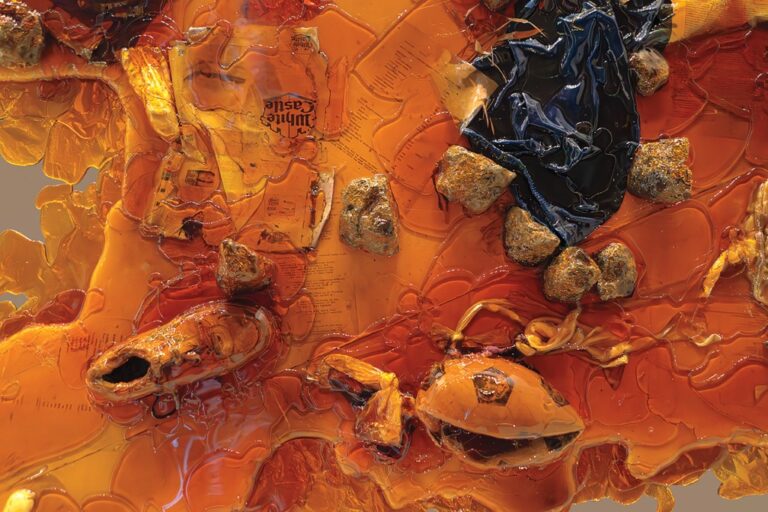While planning his solo debut at the museum at the Museum of Contemporary Art (MOCA) in Los Angeles, Eddie Rodolfo Aparicio faced an unexpected setback in the form of a permit issue. For the first time in 40 years, the city of Los Angeles was not going to grant MOCA a permit to open the elevated gallery in its Geffen Contemporary location, unless, for fire safety reasons, they could reduce the size of the room by 600. square meters adding several false walls. Aparicio did not like that solution. Instead, he proposed installing an expanding work on the floor in the center of the gallery, effectively eliminating the required floor space. The resulting work, 601 feet2 for El Playon / 601 sq. ft. for El Playon (2023), measures exactly 601 square feet. “The more site specific you can get that [designing around] a permission issue?” Aparicio joked as we walked through his exhibit.
“El Playon” in the title of the work refers to a black scar that a volcanic eruption left on the earth more than a hundred years ago, outside the capital of El Salvador. The same area was used as a dumping ground for the bodies of the disappeared during the country’s civil war of 1980-1992. Matching the shape of El Playon, 601 feet2 comprises about 1,500 pounds of molten amber that mimics flowing lava as it is poured over a collection of various objects: volcanic rocks, specially made ceramic bones, and various items found in MacArthur Park, a major hub of LA’s Salvadoran community. Also includes letters and newspaper clippings related to the Civil War that are difficult to read through the amber shell. After the show opened, Aparicio learned that his half-sister’s body had been discovered in El Playon by his father, the artist Juan Edgar Aparicio, who fled El Salvador shortly thereafter.

Installation view of the exhibition “MOCA Focus: Eddie Rodolfo Aparicio”, 2023–24, at the Museum of Contemporary Art, Los Angeles.
Courtesy Museum of Contemporary Art, Los Angeles/Photo Jeff McLane
Now, Aparicio is working on a new amber work for this year’s Whitney Biennial. It is attracted to the amber that the trees secrete as a healing mechanism. But he also plans to reiterate eventually 601 feet2. Each new version will literally be darker: the artist plans to add a new layer of spilled amber, further obscuring the documents and objects. “This is the most visible it will be,” Aparicio said. “This is how memory works, time: it is forgotten, files are erased or destroyed.”
This urge to capture something before it’s gone also appears in another ongoing series, “Rubber”. In 2016 Aparicio began releasing the lower parts of ficus trees, a ubiquitous nonnative genus in LA, where, for decades, it has been subject to eradication efforts. Apply a layer of rubber made by the Salvadoran indigenous people Elastic Castile, or Panama rubber tree. Aparicio leaves the gum on the tree for several weeks before slowly pulling it away, creating a realistic impression of the tree’s bark: the knots and whorls, man-made carvings and graffiti, discoloration from car exhaust and other pollution. At first, the works of the “Rubber” were faithful reproductions of the trees that hung on the wall like unstretched paintings. More recently, they are increasingly sculptural, as he has begun to incorporate new elements into them, such as pieces of glass or ceramic spines. Now, he is painting on their surfaces and filling some with cotton fibers from the seeds of ceiba (kapok) trees.
These works powerfully evoke the unique landscape of Los Angeles. Aparicio was “interested in the levels of human interaction that are recorded on the surface,” he said. Most of the trees he released have since been cut down, and these works now serve as the only record of their existence, of their previous lives, of the marks imprinted on them. ficus Trees still abound in Los Angeles. There is a municipal waiting list for the cut of ficus trees; the wait is more than 10 years. The wait for tree removal is much longer. Aparicio added: “All to say they can’t get rid of us even if they wanted to.”

